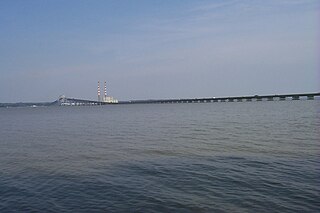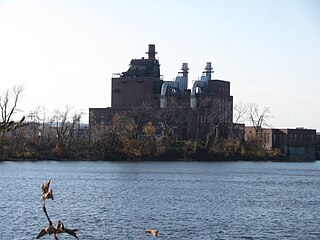
A power station, also referred to as a power plant and sometimes generating station or generating plant, is an industrial facility for the generation of electric power. Power stations are generally connected to an electrical grid.

A fossil fuel power station is a thermal power station which burns a fossil fuel, such as coal or natural gas, to produce electricity. Fossil fuel power stations have machinery to convert the heat energy of combustion into mechanical energy, which then operates an electrical generator. The prime mover may be a steam turbine, a gas turbine or, in small plants, a reciprocating gas engine. All plants use the energy extracted from the expansion of a hot gas, either steam or combustion gases. Although different energy conversion methods exist, all thermal power station conversion methods have their efficiency limited by the Carnot efficiency and therefore produce waste heat.
GenOn Energy Holdings, formerly Mirant Corporation, was a subsidiary of GenOn Energy, and is now a part of NRG Energy.

NRG Energy, Inc. is an American energy company, headquartered in Houston, Texas. It was formerly the wholesale arm of Northern States Power Company (NSP), which became Xcel Energy, but became independent in 2000. NRG Energy is involved in energy generation and retail electricity. Their portfolio includes natural gas generation, coal generation, oil generation, nuclear generation, wind generation, utility-scale generation, and distributed solar generation. NRG serves 6 million retail customers in 24 US states including Texas, Connecticut, Delaware, Illinois, Maryland, Massachusetts, New Jersey, New York, Pennsylvania, Ohio; the District of Columbia, and eight provinces in Canada.
An integrated gasification combined cycle (IGCC) is a technology using a high pressure gasifier to turn coal and other carbon based fuels into pressurized gas—synthesis gas (syngas). It can then remove impurities from the syngas prior to the electricity generation cycle. Some of these pollutants, such as sulfur, can be turned into re-usable byproducts through the Claus process. This results in lower emissions of sulfur dioxide, particulates, mercury, and in some cases carbon dioxide. With additional process equipment, a water-gas shift reaction can increase gasification efficiency and reduce carbon monoxide emissions by converting it to carbon dioxide. The resulting carbon dioxide from the shift reaction can be separated, compressed, and stored through sequestration. Excess heat from the primary combustion and syngas fired generation is then passed to a steam cycle, similar to a combined cycle gas turbine. This process results in improved thermodynamic efficiency compared to conventional pulverized coal combustion.
The Keystone Generating Station is a 1.71-gigawatt, coal power plant located on roughly 1,500 acres (610 ha) in Plumcreek Township, southeastern Armstrong County, Pennsylvania near Crooked Creek, just west of Shelocta, Pennsylvania.

The Conemaugh Generating Station is a 1,872 MW baseload coal-powered plant located on 1,750 acres (710 ha), across the Conemaugh River from New Florence in Western Pennsylvania.

Dickerson is an unincorporated community in Montgomery County, Maryland. It is on Maryland Route 28, between Sugarloaf Mountain and the Potomac River. It is a community near the town of Poolesville, Maryland. Dickerson is 61.5 square miles (159 km2).

The Morgantown Generating Station is a 1,477 MW electric generating plant owned by GenOn Holdings LLC., located in the unincorporated town of Newburg, Maryland, near Morgantown, on the Potomac River. The station was built in 1970.

The Chalk Point Generating Station is an electricity-generating plant, comprising oil and natural gas fired units, owned by NRG Energy, located near the town of Eagle Harbor, Maryland, United States, on the Patuxent River.

The Gould Street Generating Station was a former 100 MW electric generating plant operated by Exelon that was located on Gould Street in south Baltimore, Maryland, USA. The plant was adjacent to an elevated section of freeway I-95 and was south of the Riverside neighborhood and west of the Locust Point neighborhood of Baltimore. The plant site, located on the shore of the Middle Branch of the Patapsco River, was used for the generation of electric power for over one hundred years before being shut down on June 1, 2019. The site was purchased by Greenspring Realty Partners, Inc. for $3.1 million in December 2019. Demolition began in October 2020. The original brick buildings, the large storage tanks behind them, and other minor structures on the southwest portion of the property were demolished as of March 2021, but as of April 2022 the larger steel building to the northeast on the property remains. A large portion of the property was acquired by Weller Development in July 2021 and the future of the remaining structure and the property is not known.

The Potrero Generating Station was a natural gas and diesel burning electricity generating station owned by Mirant and located on a 23-acre (9.3 ha) site in Potrero Point, San Francisco, California. The plant's primary power source was a 206 MW, natural gas burning steam turbine providing baseload power and referred to as "Unit 3". In addition, three 52 MW peaking power diesel generators provided additional power during times of highest consumption. Since the closure of the Hunters Point Power Plant in 2006, Potrero was the last remaining fossil fuel power plant within the confines of San Francisco, with capacity to provide approximately 1/3 of the City's peak electrical power needs.

The Tilbury power stations were two thermal power stations on the north bank of the River Thames at Tilbury in Essex. The 360 MW dual coal- and oil-fired Tilbury A Power Station operated from 1956 until 1981 when it was mothballed, prior to demolition in 1999. The 1,428 MW Tilbury B Power Station operated between 1968 and 2013 and was fueled by coal, as well as co-firing with oil and, from 2011, biomass. Tilbury B was demolished in 2016–19. Since 2013 three other power stations have been proposed or constructed in Tilbury.
The Charles P. Crane Generating Station was a 400 megawatt (MW) coal power plant located on the Carroll Island Road in Bowleys Quarters, Maryland, 14 miles (23 km) east of Baltimore. The power plant was operated by C.P. Crane, LLC, a subsidiary of Avenue Capital Group. The station had two coal-fired generating units, rated at 190 and 209 MW nominal capacity, and powered by cyclone steam boilers. It also had a 16 MW oil-fired combustion turbine. The Crane station occupies 157 acres (64 ha) on the Middle River Neck Peninsula adjacent to the Seneca Creek tributary of the Gunpowder River, and is on the rural side of the Baltimore County Urban Rural Demarcation Line. The plant was closed in June 2018 and demolished via building implosion in August 2022.

The Herbert A. Wagner Generating Station is an electric generating station located on Fort Smallwood Road north of Orchard Beach in Anne Arundel County, Maryland, just east of Glen Burnie, and is operated by the Raven Power Holdings, LLC, a subsidiary of Riverstone Holdings LLC. The H. A. Wagner station consists of natural gas fueled Unit 1, nominally rated at 133 MWe, coal-fired Unit 2 rated at 136 MWe, coal-fired Unit 3 rated at 359 MWe, and oil-fired Unit 4 rated at 415 MWe. Talen Energy will convert the coal-fired units to alternative fuels by 2025.

James M. Barry Electric Generating Plant, also known as Barry Steam Plant or Plant Barry is a coal- and natural gas-fired electrical generation facility in Bucks, Mobile County, Alabama, United States. It lies on the west bank of the Mobile River, using it both for coal delivery as well as for cooling water. The plant was named for James M. Barry, President of Alabama Power Company from 1949 to 1952. As of 2018, the plant has 9 units, seven of which are powered by gas and two which are powered by coal.

The West Springfield Generating Station, also known by its corporate name EP Energy Massachusetts, LLC, is a fossil-fuel-fired power plant located in West Springfield, Massachusetts. The station is a "peaking" facility, meaning that it primarily operates during peak electrical demand. The facility consists of two 49-megawatt (MW) combustion turbine generators fueled by natural gas or ultra low-sulphur diesel fuel, one 18 MW jet turbine that is fueled by kerosene, and one 107 MW simple-cycle steam boiler unit burning no. 6 fuel oil, ULSD or natural gas. The station also has a small auxiliary boiler for process and building heat and an emergency back-up generator. The station's management also operates several small remote power generators including two other jet turbines identical to West Springfield 10 which are the Doreen Street unit in Pittsfield, Massachusetts, and Woodland Road unit in Lee, Massachusetts as well as five run-of-river hydroelectric power stations located on the Chicopee and Deerfield Rivers.

The R. Paul Smith Power Station is a closed electric generating plant owned by FirstEnergy in Williamsport, Maryland.

Gateway Generating Station (GGS), formerly Contra Costa Unit 8 Power Project, is a combined-cycle, natural-gas-fired power station in Contra Costa County, California, which provides power to half a million customers in northern and central California. Gateway Generating Station is on the southern shore of the San Joaquin River, in Antioch, and is one of more than ten fossil-fuel power plants in Contra Costa County.

















